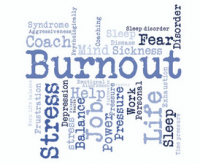If burnout is, as one author describes it, a "broken promise," what was the original promise?
I had never planned to write an article about burnout. In fact, when my prior Business Development Associate – a Millennial – pitched the idea to me in late 2019, I didn't think it would have broad enough appeal to most of our readers. At the time, most burnout-related articles were about Millennials.
Now, with the lived experience over the past 18 months, I'm more sympathetic to the topic because it has broadened to include generations other than Millennials, including my own Baby Boomer generation.
In researching material on this topic, I came across a recent article, "Is That All There Is? Why Burnout Is A Broken Promise" by Whizy Kim. The title hooked me, making me wonder what promises are being broken that lead to burnout.
Employer – "I've Got Open Positions, Yet People Don't Want to Work"
Over the past few months, I've talked with a number of executives and managers in various industries who've all said something like "I'm having a hard time filling my open positions because people are getting too comfortable with unemployment benefits that are overly generous!"
Knowing some people who have been on unemployment, I can say these benefits – even with the $300 per week enhanced federal unemployment benefit – were not generous enough to replace their lost income. These people did still actively look for work, because they wanted AND needed to work.
During this past summer, a number of states unknowingly conducted "natural experiments" to assess the relationship between higher benefits and the state's employment level. In June 2021, about half the states cut off the $300 per week enhanced benefit for their residents. Their hypothesis – cutting off these benefits would encourage large numbers of unemployed workers to search for work and accept open positions.
In late August 2021, the Bureau of Labor Statistics (BLS) released its monthly summary of state employment and unemployment, calculating the change in unemployment rates between June and July 2021.
The result? Of the 26 states that eliminated the $300 per week benefit, only 9 saw a statistically significant drop in their unemployment rates from June to July, while the other 17 states saw no statistically significant changes.
In other words, "People don't want to work because unemployment benefits are too generous" seems to be a reasonable explanation for employers' hiring challenges, yet the numbers do not bear it out.
Job Seeker – "Your Company's Working Conditions and Pay Are Not Enough to Attract Me"
Why might people not be going back to work? I've read several possible explanations, including:
- Workers left the child care and elder care fields, meaning employees who depended on these services now had to stay home themselves to care for children or older relatives.
- The lockdowns from March 2020 to May 2020 gave employees time to reflect on their jobs and conclude they were not as desirable as they had thought.
- Many front-line workers – such as grocery and retail clerks, and delivery persons – believed contracting the coronavirus was too great a risk to take with their lives or with the lives of others in their household.
- Healthcare workers were overwhelmed and exhausted, and many decided to change careers.
- Employees in restaurants and hotels were laid off or had their hours cut drastically, with no end in sight until the pandemic came under control.
- Many people – whether employed or not – decided to start their own business in 2020, driving a record increase in the BLS numbers on business formation.
- Some number of people opted for early retirement, even if they had previously planned to work several more years.
- People who worked from home found they liked having this option because it eliminated their travel time, yet their employer required them to return to the office.
The pandemic allowed people to try new work arrangements, or even start new careers. Because people found they attached more value to the new arrangements than their prior ones, they wanted more pay to give these up.
Burnout
As we’ve seen, there’s currently an expectations gap between employers and job seekers. Even if employers increased pay, there is still the issue of working conditions. This is where burnout comes in.
What exactly is "burnout"?
- Psychologist Herbert Freudenberger coined the term in the 1970s and described it as follows in 1981 – “Burnout really is a response to stress. It's a response to frustration. It's a response to a demand that an individual may make upon themself in terms of a requirement for perfectionism or drive.”
- The World Health Organization (WHO) described it this way in 2019 – “Burn-out is a syndrome conceptualized as resulting from chronic workplace stress that has not been successfully managed. It is characterized by three dimensions: 1) feelings of energy depletion or exhaustion; 2) increased mental distance from one’s job, or feelings of negativism or cynicism related to one's job; and 3) reduced professional efficacy. Burn-out refers specifically to phenomena in the occupational context and should not be applied to describe experiences in other areas of life.”
Stress. Frustration. Exhaustion. Negativism. While many occupations or specific workplaces might trigger these symptoms, the pandemic greatly expanded the number of people dealing with them.
I should know, because I experienced some level of burnout several times since March 2020. Ensuring my business had adequate capital to ride out the storm, working to re-tool our business development efforts when the places representing my best opportunities – restaurants and business events – were closed or went virtual, keeping staff motivated, and continuing to serve clients whose business was minimally impacted caused me to experience stress, frustration, exhaustion, and negativism.
These factors drained me of creativity and motivation. Without creativity, I have a hard time devising solutions for clients and coming up with business development ideas. Without motivation, I do not feel up to addressing the challenges to my business caused by COVID-19.
What Promises Are Being Broken?
The original article I cited references a piece in The Atlantic by Dr. Richard Gunderman, who believed medical students had a higher rate of burnout than other college students because the educational environment did little to nurture compassion – even though patients want this trait in doctors.
Dr. Gunderman believes burnout comes from "the sum total of hundreds and thousands of tiny betrayals of purpose, each one so minute that it hardly attracts notice." Focusing on symptoms, and not the patient as a whole. Being pressured to "move on" to the next patient, even though the current one is shocked by her diagnosis and needs questions answered. Receiving a dressing-down in front of other medical students, who could have just as easily made the same mistake. Brief and seemingly small incidents like these accumulate and eventually take their toll.
Here's an excerpt from the first article describing how these feelings and experiences drive burnout:
This is why burnout hits when work fails to live up to our expectations of it. Many of us were raised on the mantra: "It's not work if you love what you do," and so we want to believe that our jobs can not only provide financial stability, but also emotional and spiritual nourishment.
The broken promise lies in how we were raised – not only in the mantra quoted, but also in looking to work to provide emotional fulfillment. We have internalized sayings and teachings from the adults who raised, educated, and otherwise helped us become adults – these have now become OUR expectations, so the promises being broken are those stemming from our own expectations.
I have a friend who is a pastor, a job that seems very emotionally fulfilling. Yet he would tell you that being a pastor is much like any other job – there are tasks and responsibilities you love doing, and those you wish you could avoid. In fact, his experience of seminary sounds like that of the medical students – a focus on learning so intense it deadened his spirituality and strained his emotional health, which he managed to address and gradually recover once he began working in a congregation.
So Now What?
Even though burnout is now more widely discussed because it has spread beyond Millennials, there does not seem to be any easy way to address it. Perhaps the best, and most concise, advice I've found comes from the book, Secrets of an Executive Coach: Proven Methods for Helping Leaders Excel Under Pressure, by Alan Downs. In Chapter Twelve, the author – a PhD psychologist – describes "The Crisis of Passion."
Near the end of that chapter, the author's advice is to find "the courage to begin to explore and honor" our feelings. Too often, we are so focused on, and busy with, our jobs we push our feelings aside, and jump straight to thinking and acting. The author suggests asking "'What do I feel about this?' before trying to intellectually sort out the situation."
This advice is similar to a technique I learned in a recorded teaching talk by Tara Brach, a PhD in Clinical Psychology who is a Buddhist meditation teacher in the Washington, DC area. The essence of the technique is this – Fully Experience the Experience, Then Let It Go. You fully experience something by recognizing, honoring, and releasing your emotions attached to it, as quickly and as fully as possible – only after you've done that can you put the experience behind you.
A Simple Step
Could the first step in addressing burnout be as simple as asking "What do I feel about this?" then honoring the feelings you've cataloged and releasing them completely to the wind, and only then begin to think and act? Taking this first step seems so out of place in a world enchanted by efficiency, next-day delivery, computers, processes, metrics, and the like. Still, it's a step that helped me – perhaps it will help you, too.
Sincerely,
![]()
Todd L. Herman







